You know how important it is to maintain your dog’s overall health, but have you ever considered how often you should brush their teeth? It’s not just about fresh breath; regular brushing helps prevent more serious dental issues. But how often is ‘regular’? Surprisingly, this isn’t a one-size-fits-all answer. The ideal frequency depends on several factors, from your dog’s breed to their age. So, let’s discuss it further, shall we?
Understanding Canine Dental Health
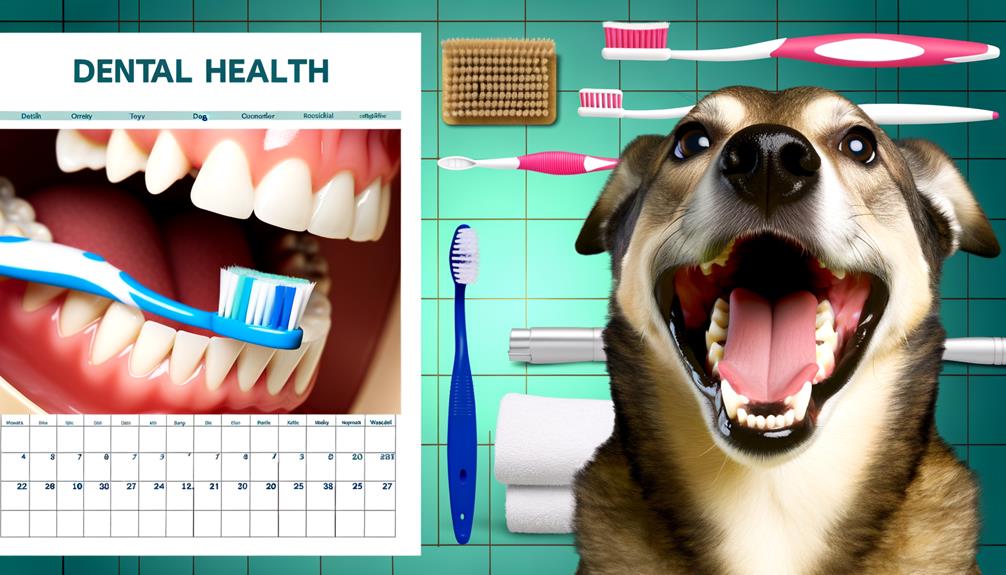
Just like humans, your dog’s dental health plays a crucial role in their overall well-being. It’s not just about a fresh breath or shiny teeth, it’s an essential part of their health system. Ignoring it can lead to Canine tooth decay, a common but serious issue. This isn’t just about cavities, it can lead to pain, tooth loss, and even organ damage if bacteria enter the bloodstream through the gums.
You might think that dry kibble will keep your dog’s teeth clean, but that’s a common misconception. While it might scrape off some plaque, it won’t get rid of it all. That’s where dog mouthwash comes in. It’s an easy way to improve your dog’s oral hygiene, and it’s especially handy for dogs that don’t enjoy having their teeth brushed. However, it’s not a magic solution – it’s just one part of a comprehensive dental care routine.
Importance of Regular Teeth Brushing
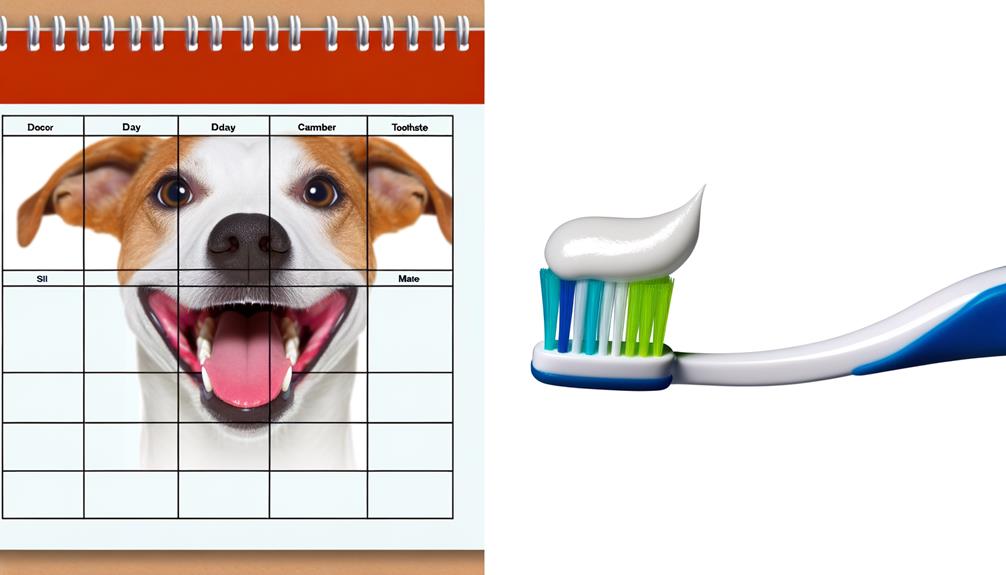
In the fight against dental disease, brushing your dog’s teeth on a regular basis is an essential tool. It’s not just about fresh breath, but more about the oral hygiene benefits that come with it. Regular brushing prevents the accumulation of plaque and tartar, which are the main causes of canine mouth diseases.
Plaque and tartar buildup can lead to serious health issues, such as periodontal disease, a common but preventable condition in dogs. If left unchecked, it can cause discomfort, infection, and even tooth loss. Not only that, but the bacteria can enter your dog’s bloodstream, potentially affecting their heart, liver, and kidneys.
But it’s not all doom and gloom. With consistent teeth brushing, you’re taking a proactive step in ensuring your dog’s overall health. It aids in the removal of food particles and reduces the risk of gum disease. Plus, it’s a great opportunity to check for any abnormalities such as swollen gums, broken teeth, or oral tumors.
Determining the Ideal Frequency
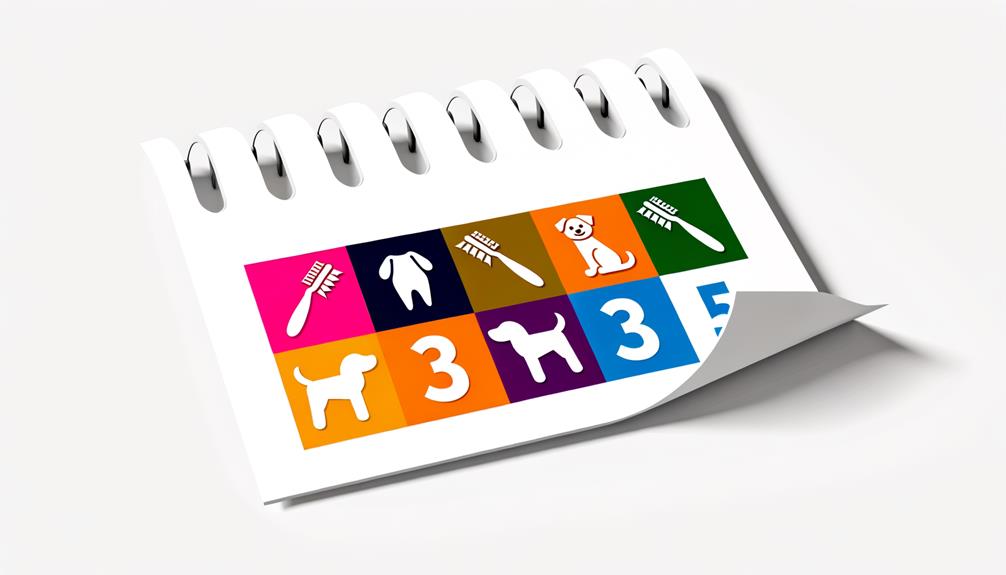
Now, let’s determine how often you should brush your dog’s teeth.
Firstly, you need to understand your dog’s specific needs and what factors may influence their dental health.
Then, you can review veterinary recommendations and consider the overall impact of dental health on your furry friend’s wellbeing.
Understanding Your Dog’s Needs
To determine the ideal frequency for brushing your dog’s teeth, you’ll need to understand your furry friend’s specific needs. This involves considering a range of factors such as:
- Your dog’s age: Puppies have different dental needs than adult dogs.
- The breed: Some breeds are more prone to dental diseases.
- Canine nutrition: A dog’s diet can greatly affect oral health.
- Dog grooming habits: Regular brushing and cleaning can influence how often you need to brush their teeth.
- Overall health: Some health conditions require more frequent brushing.
Every dog is unique, and its needs will vary. Remember, proper dental hygiene is a vital part of dog grooming and contributes to their overall well-being. Make it a priority, and your pup will thank you!
Veterinary Recommendations
Once you’ve got a handle on your dog’s individual needs, it’s time to consult with a vet for their expert advice on how often to brush those canine teeth. Your vet can assess your pet’s oral health, taking into account any dental diseases that may already be present. They’ll also consider dietary influences on your dog’s teeth. Some foods can increase plaque buildup, requiring more frequent brushing. Based on these factors, your vet will propose a brushing frequency tailored to your dog.
Don’t shy away from asking questions during this consultation. It’s essential to understand the reasoning behind the vet’s recommendations, as they’re centered around preventing future dental issues. Keep in mind, their advice is based on your dog’s current oral health.
Impact of Dental Health
Understanding your dog’s dental health is key in determining the ideal frequency for brushing their teeth. Certain factors significantly impact their oral health, including:
- Dietary influences: The food your dog eats can affect their teeth. For instance, dry food might help scrape off plaque, while soft food could stick to teeth and cause decay.
- Chew toys impact: Chew toys can clean your dog’s teeth naturally and reduce the frequency of brushing.
- Age: Older dogs often have more dental issues, requiring more frequent brushing.
- Breed: Some breeds are more prone to dental health problems.
- Overall health: Dogs with certain health conditions might need extra dental care.
Types of Dog Toothbrushes
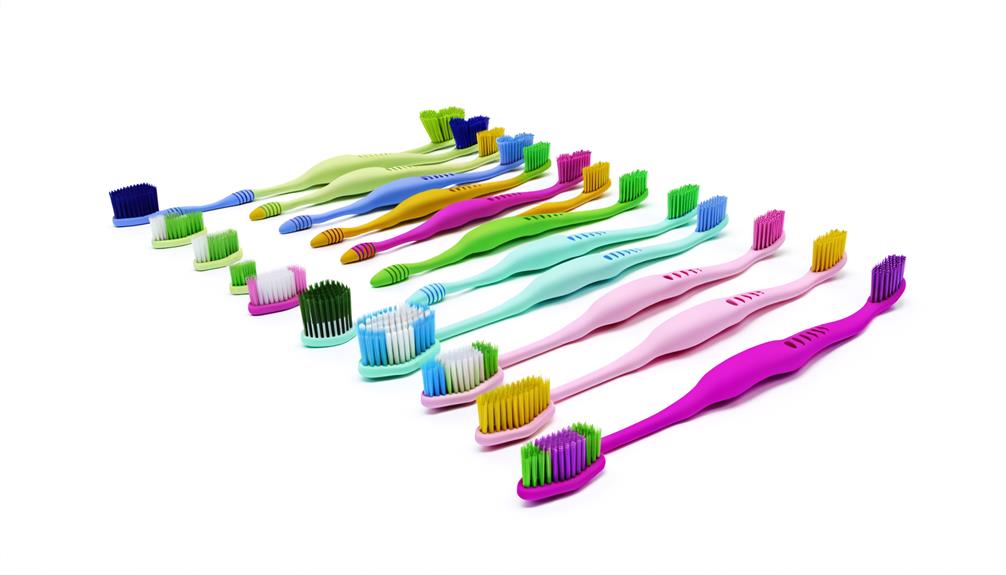
When it comes to brushing your dog’s teeth, you’ll find several types of toothbrushes designed specifically for canines. These tools differ in terms of toothbrush durability and innovative designs, offering a range of options to cater to your pet’s specific needs.
Firstly, there are standard dog toothbrushes, which closely resemble human ones. They’re known for their durability and are typically made with sturdier bristles to withstand your dog’s biting.
Finger toothbrushes, on the other hand, are small and soft brushes designed to fit over your finger. They provide increased control and are ideal for smaller breeds or dogs that are new to dental hygiene.
Dual-headed toothbrushes are yet another innovative design. These have bristles on both ends, each suited for different teeth sizes, making it easier to reach every corner of your dog’s mouth.
You’ll also find electric toothbrushes for dogs, which function similarly to those for humans. They offer a deep clean but might require some time for your dog to adjust.
Lastly, there are chewable toothbrushes, a product of innovative design. These look like toys but have bristles and grooves to clean teeth as the dog chews, promoting self-dental care. Each type has its pros and cons, so pick one that best suits your dog’s temperament and dental needs.
Choosing the Right Dog Toothpaste
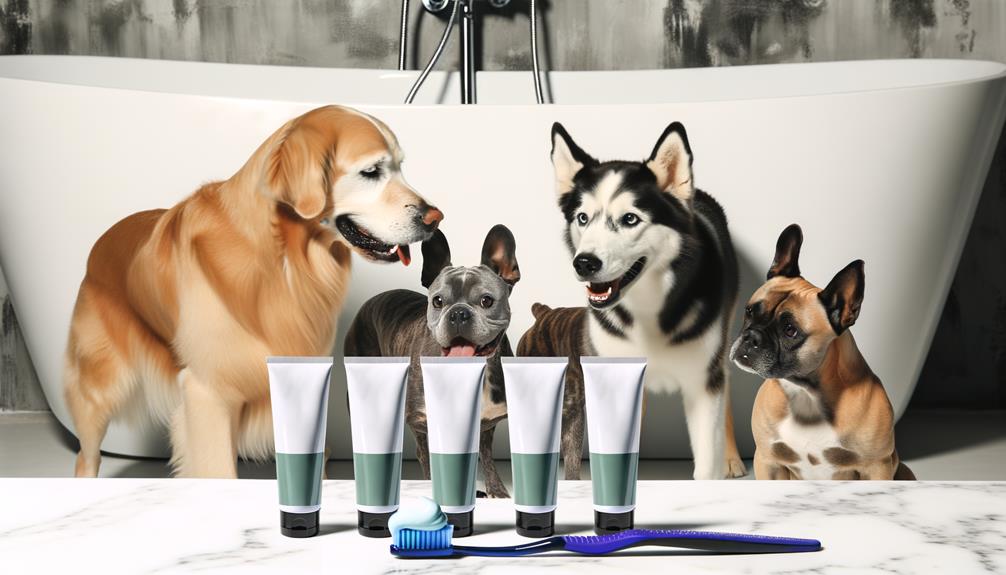
Choosing the right toothpaste for your dog isn’t just about brand names.
It’s crucial to evaluate the ingredients and ensure they’re safe and beneficial for your pet’s dental health.
Don’t forget, your vet’s recommendation is also a key factor to consider in this decision.
Selecting Suitable Toothpaste Brands
You’ll find a myriad of dog toothpaste brands on the market, but it’s essential to pick one that’s both safe and effective for your pet. When choosing, look out for the following:
- Toothpaste flavors: Dogs prefer meat-flavored toothpaste over minty ones, so pick a flavor your dog will love.
- Packaging convenience: Choose a brand that’s easy to use, ideally one with a nozzle for direct application.
- Vet-approved: Ensure that the brand has a seal of approval from veterinary associations.
- Positive reviews: Check online for positive reviews from other pet owners.
- Non-foaming: Dogs can’t spit, so opt for a non-foaming toothpaste.
Choose wisely to make your dog’s tooth-brushing experience more pleasant and effective.
Evaluating Toothpaste Ingredients
After settling on a brand, it’s crucial to scrutinize the ingredients list of your chosen dog toothpaste. Beware of toxic ingredients avoidance, as certain substances harmful to humans are equally dangerous to dogs. These include xylitol, a sweetener that’s deadly to dogs, and fluoride, which can lead to poisoning if ingested in large amounts.
It’s worth noting the risks of using human toothpaste, which often contains these harmful ingredients. Despite its convenience, it’s not a safe option for your furry friend. Instead, opt for a toothpaste specifically formulated for dogs. Remember, the health of your dog’s teeth and gums depends not just on how often you brush, but also on the quality and safety of the toothpaste you use.
Importance of Vet’s Recommendation
While it’s important to avoid harmful ingredients in your dog’s toothpaste, it’s equally beneficial to seek your vet’s advice when picking the right product. Your vet’s experience and medical backing are crucial factors that can guide you through the selection process.
Consider these reasons:
- Vets have extensive knowledge about canine oral health, allowing them to provide tested and proven recommendations.
- They can evaluate your dog’s specific needs and suggest toothpaste that caters to them.
- Vets are updated on the latest oral products for dogs, ensuring you choose only the best.
- They understand the potential risks and benefits associated with different toothpaste brands.
- Your vet can provide guidance on how to effectively use the toothpaste for optimal results.
Therefore, never underestimate the importance of your vet’s recommendation when choosing the right toothpaste for your dog.
Step-by-Step Guide to Brushing
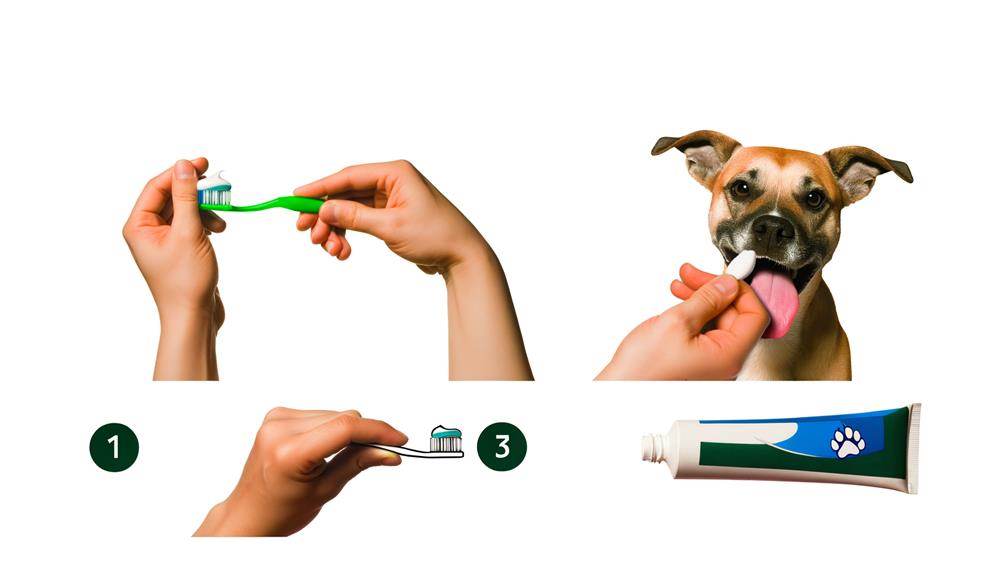
Let’s dive right into a simple, five-step routine to effectively brush your dog’s teeth.
Step one is to prepare your tools. You’ll need a dog-specific toothbrush and toothpaste. Human toothpaste can harm your pet, so it’s crucial to use a dog-approved product.
Next, let your dog taste the toothpaste before you start brushing. This will help them get used to the flavor, making the brushing process less stressful.
For step three, lift your dog’s lip to expose their teeth. Use gentle brushing techniques, moving the brush in small, circular motions. Focus on the gum line, where most plaque build-up occurs.
Step four involves rewarding cooperation. After a successful brushing session, give your dog a treat or their favourite toy. This positive reinforcement will help them associate tooth brushing with good things, making future sessions easier.
Lastly, maintain a regular routine. Consistency is key in dental hygiene. Aim to brush your dog’s teeth daily, but if that’s not possible, aim for at least three times a week.
Addressing Resistance to Teeth Brushing
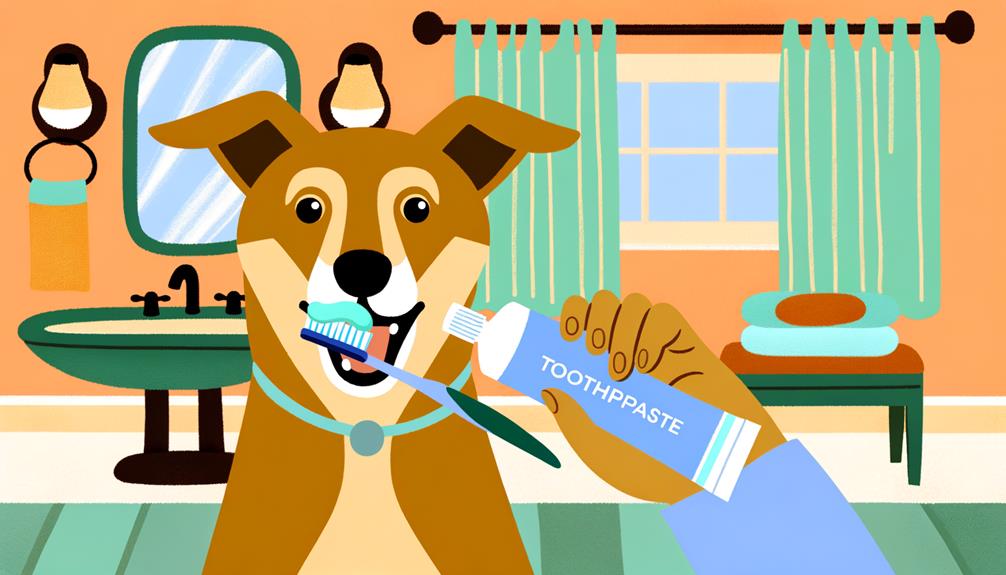
If your furry friend shows resistance to teeth brushing, it’s important to address this issue promptly to ensure good dental health. Understanding dog psychology can be a great help in this regard. Here are some strategies to address your dog’s resistance:
- Take it slow: Introduce your dog to teeth brushing gradually. Start with letting them taste the toothpaste, then move on to touching their teeth with your finger.
- Use positive reinforcement: Adopt a reward system. Offer treats, praises, or extra playtime after each successful brushing session.
- Make it a routine: Dogs thrive on routine. Make teeth brushing a consistent part of your dog’s daily schedule to help them get used to it.
- Use dog-friendly products: Use toothpaste and brushes designed specifically for dogs. They’re often flavored to make the experience more enjoyable for your pet.
- Be patient and persistent: It might take some time for your dog to adapt to teeth brushing. Don’t give up.
Professional Dental Cleanings for Dogs
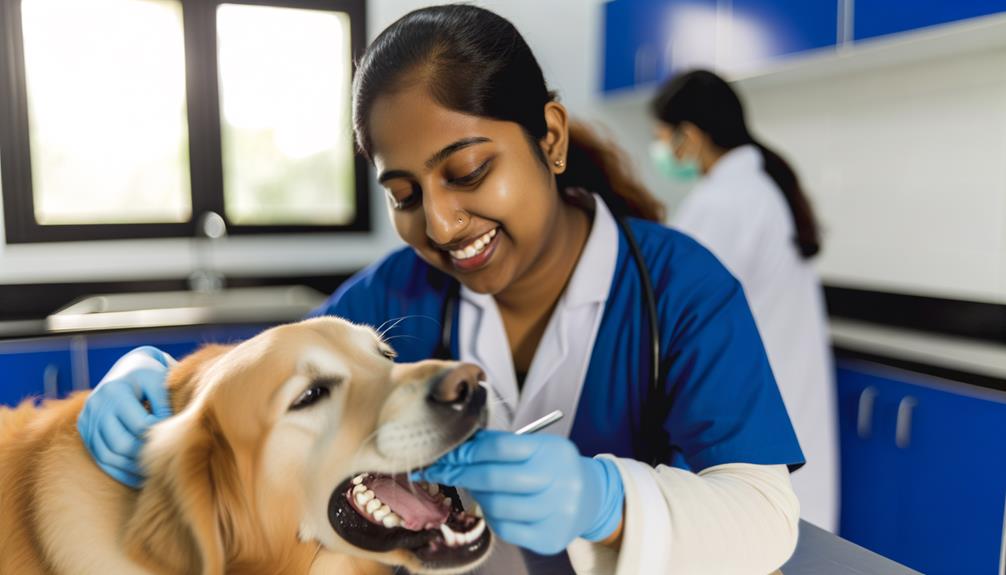
Beyond regular at-home care, your dog may also benefit from professional dental cleanings. These cleanings can provide a deep and thorough cleaning that’s hard to achieve with brushing alone. But, it’s important to consider both the benefits and the risks.
The main risk is anesthesia. While it’s generally safe, there are always anesthesia risks involved. Your vet will likely conduct a pre-anesthetic exam to ensure your dog is healthy enough for the procedure. Still, it’s something you’ll want to discuss in detail with your vet.
Then, there’s the cost. Dental treat costs can add up, especially if your dog requires multiple cleanings. Some pet insurance plans may cover a portion of the cost, but others may not. It’s best to check with your provider ahead of time.
Frequently Asked Questions
Is There a Specific Age to Start Brushing a Puppys Teeth?
You should start brushing your puppy’s teeth as soon as they come in. It’s essential to choose the right puppy toothpaste and learn proper brushing techniques to maintain their oral health.
Can a Dogs Diet Affect Its Dental Health?
Absolutely, your dog’s diet can impact its dental health. Certain foods can promote plaque, while others, like chew toys, can help clean teeth. It’s vital to consider dietary impacts when caring for your pup’s teeth.
What Are Some Signs of Dental Problems in Dogs?
You’ll notice signs of dental problems in dogs like persistent bad breath and gum inflammation. Don’t ignore these symptoms. Seek remedies such as professional dental cleaning or specialized chews to freshen your dog’s breath.
Are There Any Alternatives to Brushing for Maintaining My Dogs Dental Hygiene?
Yes, there are alternatives. Chew toys can be effective in maintaining your dog’s dental hygiene. Dental treats also offer benefits, as they’re designed to clean teeth and freshen breath while your pet munches on them.
Can Human Toothpaste Be Harmful to Dogs?
Yes, human toothpaste can be harmful to dogs. Certain toothpaste ingredients, like fluoride, are toxic to them. Also, artificial sweeteners can cause canine allergies. Always use dog-specific toothpaste for your pet’s dental hygiene.
Conclusion
So, keeping Fido’s pearly whites clean isn’t as tough as you’d think! Brushing 2-3 times a week, using the right tools, and picking the best toothpaste can make a world of difference.
If your pup’s resistant, take it slow and consult with your vet. Remember, professional cleanings are also a must. Ensuring your dog’s oral hygiene isn’t just about fresh breath, it’s vital for their overall health too.
Start brushing today!







